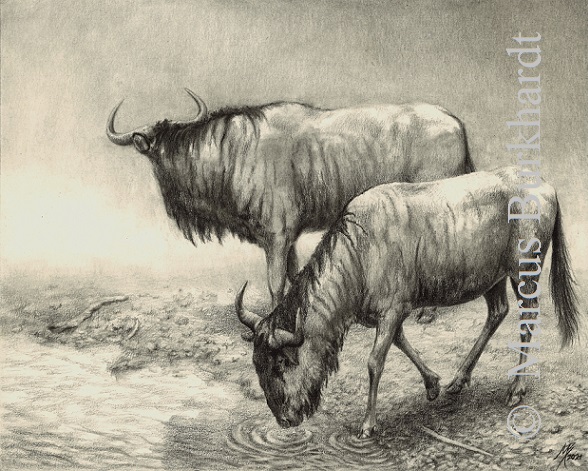
Southern blue wildebeest (Connochaetes taurinus)
Pencil, 2021
30 x 24 cm

Southern blue wildebeest (Connochaetes taurinus)
Pencil, 2021
30 x 24 cm

Summary of all fossil Alcelaphini-genera with selected species
Coloured pencil drawings, digitally composed; 2018
The reconstructions were made with kindly support by paleontologist Dr. Faysal Bibi from the Museum for Natural History Berlin.
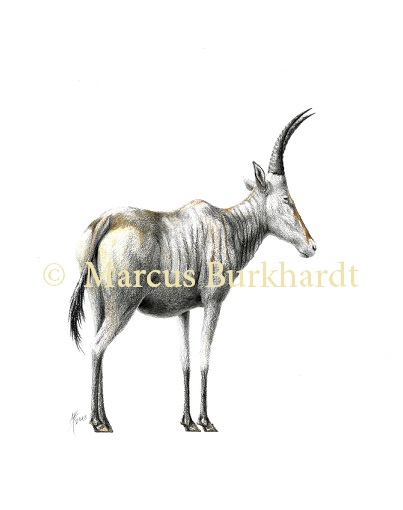
Numidocapra crassicornis (Bovidae), Early Pleistocene, North- and East Africa
Fossils of this widespread species were found in Ethiopia, Djibouti and Algeria. Temporary it was placed in Caprinae. A special feature are the horns that curve foreward in side view. The name means “goat from Numidia”, an ancient kingdom in North Africa.
Coloured pencil, 2018
30 x 24 cm
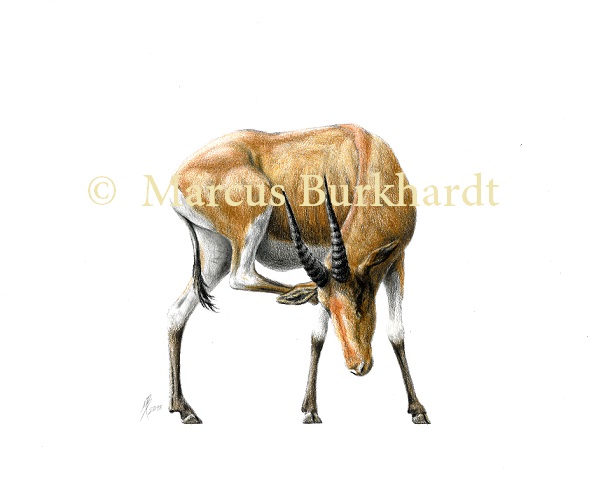
Awashia suwai (Bovidae), Late Pliocene, Ethiopia
A. suwai was found at the Matabaietu formation which is located at the eponymous river Awash in Ethiopia. It lived there about 2,5 million years ago together with hominids like Australopithecus garhi and maybe Paranthropus aethiopicus.
Coloured pencil, 2018
30 x 24 cm
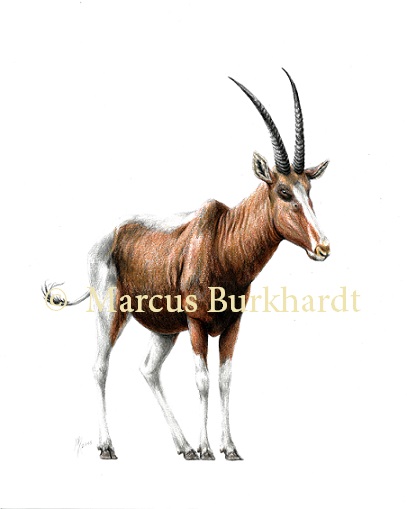
Damalops palaeindicus (Bovidae), Late Pliocene, South Asia
This is a notably species in two aspects: on the one hand it is the only known alcelaphine outside of Africa, on the other hand its horn form is very simple compared to other Alcelaphini. D. palaeindicus lived during the Pinjor formation about 2,5 million years ago in the area of today’s Siwaliks (southern Himalayas) in India. There are also remains from the Republic of Tajikistan.
Coloured pencil, 2018
30 x 24 cm
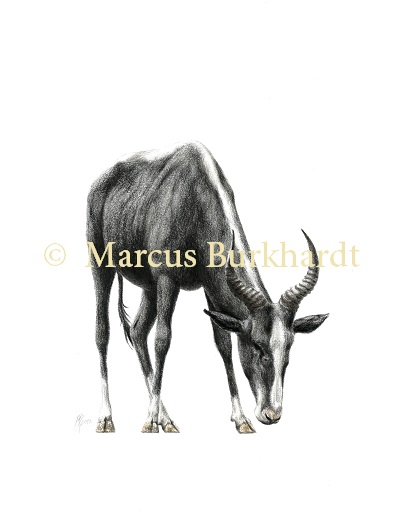
Parmularius maasaicus (Bovidae); Pleistocene, East Africa
A medium-sized alcelaphine which was only found at Olduvai Gorge. I could be an ancestor of the extant hartebeests (Alcelaphus). It was named in honor of the Maasai people who live in the Olduvai Gorge area.
Coloured pencil, 2018
30 x 24 cm
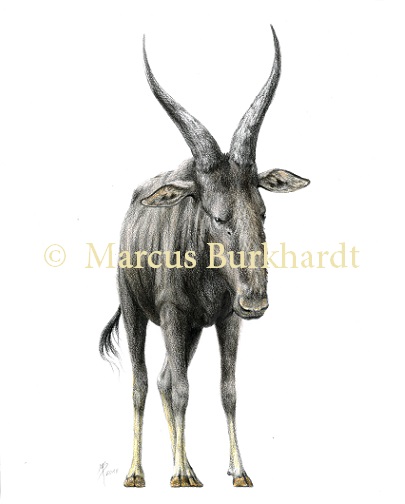
Megalotragus kattwinkeli (Bovidae), Pleistocene, East Africa
M. kattwinkeli is with expected 250 kg one of the biggest alcelaphines and closely related to the modern wildebeest. The horn cores vary a lot in this species, from a more compressed type with their tips curving inwards in smaller specimens to a more elongated type in bigger individuals. There is also a tendency to a domed skull with hollows, but not as distinct like that in Megalotragus atopocranion. The locality of M. kattwinkeli is the famous Olduvai Gorge in northern Tanzania. Here it occured with Paranthropus boisei, Homo habilis and Homo erectus. It was named after the German paleontologist and neurologist Wilhelm Kattwinkel (1866 – 1935).
Coloured pencil, 2018
30 x 24 cm
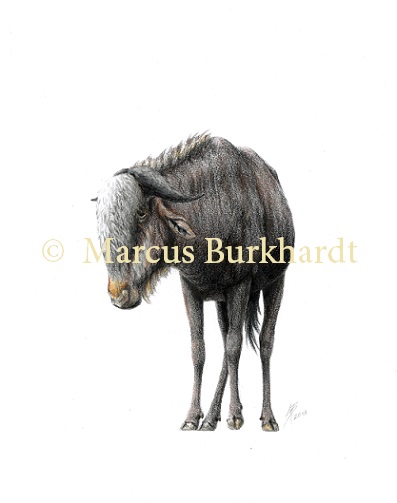
Megalotragus atopocranion (Bovidae), Late Pleistocene, East Africa
This is the most popular of fossil alcelaphines because of a unique feature in mammals: a domed skull with hollows and air passages, which probably were used for infrasonic communication with fellows. M. atopocranion was a grazer, which was possibly hunted by modern man (Homo sapiens). It is better known under its synonym Rusingoryx atopocranion, named after its location Rusinga Island at Lake Victoria.
Coloured pencil, 2018
30 x 24 cm
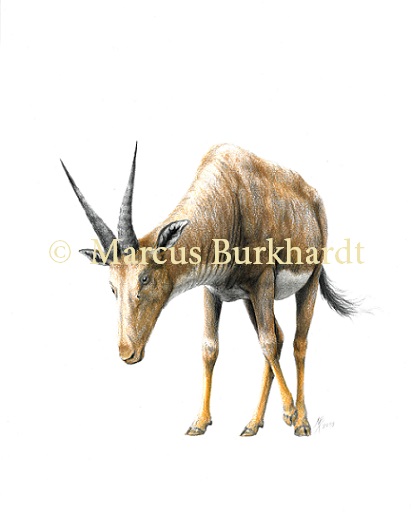
Damalborea elisabethae (Bovidae), Middle Pliocene, East Africa
This prehistoric alcelaphine was discovered at the Hadar-Formation in Ethiopia. It lived there about 3,3 million years ago together amongst others with the hominin Australopithecus afarensis. It was named after paleontologist Elisabeth Vrba.
Coloured pencil, 2018
30 x 24 cm
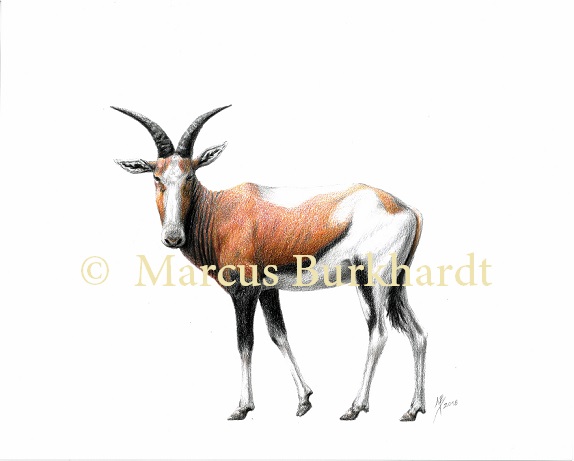
Damalacra neanica (Bovidae), Early Pliocene, South Africa
An alcelaphine that lived about 5,3 – 3,6 million years ago. Probably their feeding niches range from browsers to mixed feeders. D. neanica was about as large as today’s blesbok (Damaliscus pygargus phillipsi).
Coloured pencil, 2018
30 x 24 cm
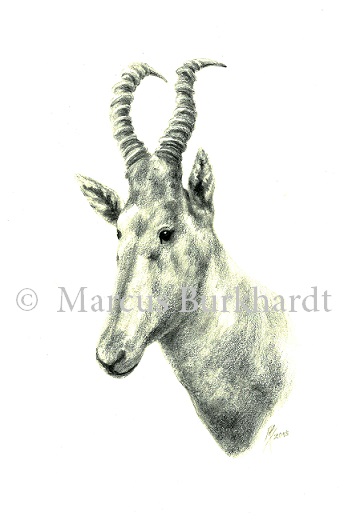
Lelwel Hartebeest (Alcelaphus lelwel), signposted at the museum as Lichtenstein’s hartebeest (Alcelaphus lichtensteinii), which is impossible because of the horn shape.
Pencil, 2018
29,5 x 21 cm
The picture was drawn from a zoological specimen at the natural history museum in Waldenburg.